

Bookmarklet. A bookmarklet is a bookmark stored in a web browser that contains JavaScript commands to extend the browser's functionality.
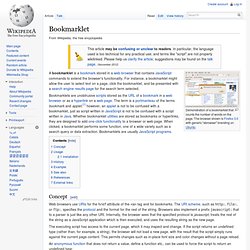
For instance, a bookmarklet might allow the user to select text on a page, click the bookmarklet, and be presented with a search engine results page for the search term selected. Concept[edit] The executing script has access to the current page, which it may inspect and change. If the script returns an undefined type (rather than, for example, a string), the browser will not load a new page, with the result that the script simply runs against the current page content. How To Make a Bookmarklet For Your Web Application. Browser buttons (bookmarklets) are shortcuts that act like a simple browser plugin.
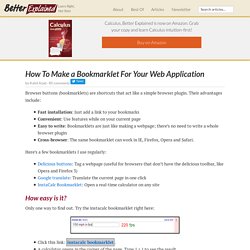
Their advantages include: Fast installation: Just add a link to your bookmarksConvenient: Use features while on your current pageEasy to write: Bookmarklets are just like making a webpage; there’s no need to write a whole browser pluginCross-browser: The same bookmarklet can work in IE, Firefox, Opera and Safari. Here’s a few bookmarklets I use regularly: Delicious buttons: Tag a webpage (useful for browsers that don’t have the delicious toolbar, like Opera and Firefox 3)Google translate: Translate the current page in one clickInstaCalc Bookmarklet: Open a real-time calculator on any site How easy is it?
Only one way to find out. Neat, eh? Today we’ll walk through the anatomy of a bookmarklet, dissect a few, and give you the tools to build your own. Custom development of web browser extensions, toolbars and plugins. Creating Gmail checker using Kango framework — Kango 1.0.0 documentation. Introduction Kango allows creating extensions for popular browsers using JavaScript only, the code being single for all major browsers.

Chrome, Firefox, Internet Explorer and Safari are supported currently. The way to create a simple cross browser Gmail Checker is represented below. Modifying content of web pages using Kango and jQuery — Kango 1.0.0 documentation. Content script Kango framework supports Greasemonkey-like user scripts.
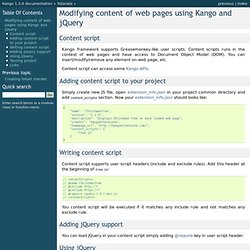
Content scripts runs in the context of web pages and have access to Document Object Model (DOM). You can insert/modify/remove any element on web page, etc. Content script can access some Kango APIs. Adding content script to your project Simply create new JS file, open extension_info.json in your project common directory and add content_scripts section. Greasemonkey. Greasemonkey is a Mozilla Firefox extension that allows users to install scripts that make on-the-fly changes to web page content after or before the page is loaded in the browser (also known as augmented browsing).
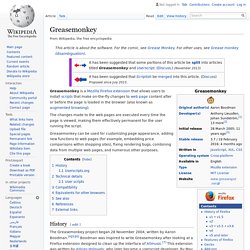
The changes made to the web pages are executed every time the page is viewed, making them effectively permanent for the user running the script. Greasemonkey can be used for customizing page appearance, adding new functions to web pages (for example, embedding price comparisons within shopping sites), fixing rendering bugs, combining data from multiple web pages, and numerous other purposes.
History[edit] The Greasemonkey project began 28 November 2004, written by Aaron Boodman.[4][5][6] Boodman was inspired to write Greasemonkey after looking at a Firefox extension designed to clean up the interface of Allmusic.[7] This extension was written by Adrian Holovaty, who later became a userscript developer. Userscripts.org[edit]
CoffeeScript. The language has a relatively large following[citation needed] in the Ruby community.
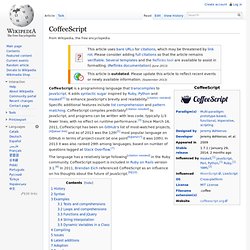
CoffeeScript support is included in Ruby on Rails version 3.1.[8] In 2011, Brendan Eich referenced CoffeeScript as an influence on his thoughts about the future of JavaScript.[9][10] History[edit] On December 24, 2010, Ashkenas announced the release of stable 1.0.0 to Hacker News, the site where the project was announced for the first time.[12][13] Syntax[edit] Almost everything is an expression in CoffeeScript, for example if, switch and for expressions (which have no return value in JavaScript) return a value. Many unnecessary parentheses and braces can be omitted; for example, blocks of code can be denoted by indentation instead of braces, function calls are implicit, and object literals are often detected automatically.
JayData home - JayData. Building a HTML5 iPad-compatible SPA web site. For a few weeks now I’ve been working on a HTML5-project for a customer here in Västerås.
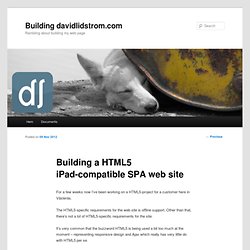
The HTML5-specific requirements for the web site is offline support. Other than that, there’s not a lot of HTML5-specific requirements for the site. It’s very common that the buzzword HTML5 is being used a bit too much at the moment – representing responsive design and Ajax which really has very little do with HTML5 per se. The way ”people” talk about HTML5 right now feels similar to how people talked about Web 2.0 – or even how people talked about ”Apps”. They know they want it, they in fact need it and are willing to spend lots of money on it.
If I sell a HTML5 Web site – what is that? Ok, nuff’ said about that. The project I’m working on will actually make use of the HTML5 offline features. SMC: The State Machine Compiler.